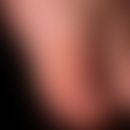Synonym(s)
abnormal sweating; axillary perspiration; increased perspiration; Sweating; underarm perspiration
DefinitionThis section has been translated automatically.
Increased underarm perspiration, usually coupled with bromhidrosis.
Occurrence/EpidemiologyThis section has been translated automatically.
Increased familial prevalence. 0.5% of the population in the USA suffer from this disease.
You might also be interested in
ManifestationThis section has been translated automatically.
Hyperhidrosis axillaris is characterized by at least 6 months of excessive sweating without known cause and additionally by 2 of the following factors:
- bilateral and symmetrical sweating
- Impairment of daily activity
- Frequency of occurrence at least once a week
- Age at onset of the disease < 25 years
- positive family history
- Reduction of sweating during sleep.
DiagnosisThis section has been translated automatically.
Clinic with the demonstrably increased sweat secretion. Minor sweating test: Remove sweat from the armpit, brush the sweat gland field with alcoholic iodine tincture, allow to dry briefly, powder with wheat starch; blue-black discoloured areas indicate sweat gland activity. For quantification of sweat secretion gravimetry of both axils. For practical work, the Hyperhidrosis Disease Severity Scale test is sufficient.
TherapyThis section has been translated automatically.
Procedure according to a controlled step-by-step plan.
- Cleaning and skin care: Regular hygiene of the armpits.
- This includes washing the armpits several times a day using deodorising syndets or soaps (Dermowas, Sebamed, etc.).
- Shaving: Remove underarm hairs to inhibit bacterial growth (Corynebacterium tenuis) (see Trichobacteriosis axillaris)
- Deodorants: Apply a deodorant several times a day to neutralize the unpleasant underarm odor. Powders have also proved effective.
- Clothing: Wear breathable shirts and undershirts cut as wide as possible (no synthetic fibres, cotton instead). No tight-fitting clothes.
- Use of antiperspirants.
- Iontophoresis: Initial: therapy trial with 10 min/day (pulse current device) 4-5 times/week for 3-4 weeks. If proven effective, continuation as home therapy with 3-4 treatments/week.
- Botulinum toxin: Only the preparation Botox is approved for the indication hyperhidrosis axillaris. The subdivision of the hyperhidrotic areas into 2 × 2 cm boxes has proven to be effective. Approximately 3 MU Botox (dilution: 100 MU Botox/5 ml 0.9% NaCl) are injected intradermally in a fan-shaped manner per box. The success of the therapy is monitored after 2-3 weeks. Remaining hyperhidrotic areas can be re-injected if necessary.
Side effect: Painfulness of the injections.Notice!
Therapies with botulinum toxin belong in the hands of an experienced doctor!
External therapyThis section has been translated automatically.
- Aluminium chloride hexahydrate gels are often successful when used consistently as first-line therapy (e.g. R004 or R006 ).
- Most commercially available antiperspirants contain aluminium salts as an efficacy determining ingredient.
- Among the commercially available preparations, SWEAT-OFF should be emphasized: for first application, apply once a day, in the evening before bedtime, for a maximum of 4 days. Then apply 1-2 times/week in the evening before going to bed.
Internal therapyThis section has been translated automatically.
- Anticholinergics, in particular Bornaprin (Sormodren Tbl.) can be tried in mild to moderate cases. Initially 2 mg/day for 1 week, then dose escalation to 4-8 mg/day as maintenance dose.
- Alternatively methanthelinium bromide (vagantine) 3 times/day 50mg =1 tbl. p.o.
- In addition to external measures, internal sage can be prescribed (e.g. 3 times/day 1 tbl. Salvysat plus Bürger tablets).
Operative therapieThis section has been translated automatically.
- In the case of axillary sweating which cannot be controlled conservatively, surgical intervention is indicated with the aim of reducing the number of apocrine (and eccrine) sweat glands. Surgical interventions are based on 3 therapeutic principles: subcutaneous curettage, open curettage with partial excision or excision of the sweat gland field with subsequent plastic covering.
- Subcutaneous curettage of the sweat glands: ITN, 2-3 cm long skin incision caudally of the sweat gland field; undermine the entire marked area with dissecting scissors, then curettage of the area with a sharp gynaecological curette both to the skin and to the fatty tissue side, suction drainage and closure of the incision site. The suction curettage showed good clinical results in a study with 25 patients.
- Sweat gland suction curettage: This low complication surgical procedure is a combination of inverse, sharp curettage of the dermal and subcutaneous apocrine glandular fields and liposuction.
- Open curettage, if necessary with partial excision: ITN, longitudinal elliptical 3-4 cm wide subtotal excision of the sweat gland field; subcutaneous mobilization of the sweat gland-bearing margins; sharp curettage; drainage; primary wound closure by subcutaneous and skin suture.
- Excision of the sweat gland field with subsequent plastic covering: ITN, different incisions adapted to the sweat gland field; closure by transposition or VY-plasty.
- Surgical measures such as endoscopic transthoracic sympathectomy (ETS) are often accompanied by neuropathic disorders and compensatory or reflex sweating. Nevertheless, > 90% of patients experience these side effects as less stressful than the symptoms of untreated hyperhidrosis.
Note(s)This section has been translated automatically.
For patients because of the visibility of sweat stains often unpleasant clinical picture, high stigma rate!
LiteratureThis section has been translated automatically.
- Connolly M (2003) Management of primary hyperhidrosis: a summary of the different treatment modalities. At J Clin Dermatol 4: 681-697
- Hamm H et al (2006) Primary focal hyperhidrosis: disease characteristics and functional impairment. Dermatology 212: 343-353
- Lonsdale-Eccles A et al (2003) Axillary hyperhidrosis: eccrine or apocrine? Clin Exp Dermatol 28: 2-7
- Lowe NJ et al (2007) Botulinum toxin type A in the treatment of primary axillary hyperhidrosis: a 52-week multicenter double-blind, randomized, placebo-controlled study of efficacy and safety. J Am Acad Dermatol 56: 604-611
- Naumann M (1998) Botulinum toxin. UNI-MED publishing house Bremen, S. 72-74
- Naumann M et al (2003) Botulinum toxin type a is a safe and effective treatment for axillary hyperhidrosis over 16 months: a prospective study. Arch Dermatol 139: 731-736
- Petres J, Rompel R (1996) Operative Dermatology, Springer, Berlin Heidelberg New-York, S. 402-405
- Stolman LP (2003) Treatment of hyperhidrosis. J Drugs Dermatol 2: 521-527
- Wollina U et al (1998) Therapy of hyperhidrosis with tap water iontophoresis. Positive effect on healing time and lack of recurrence in hand-foot eczema. dermatologist 49: 109-113
Incoming links (8)
Aluminium chloride hexahydrate gel 15/20% (nrf 11.24.); Aluminium chloride hexahydrate solution, viscose, hydrophilic 15/20% (nrf 11.132.); Botulinum toxin a; Iodine tincture; Minor sweat test; Sympathectomy, endoscopic transthoracic; Tannin; Wrinkle treatment;Outgoing links (15)
Aluminium chloride hexahydrate gel 15/20% (nrf 11.24.); Aluminium chloride hexahydrate solution, viscose, hydrophilic 15/20% (nrf 11.132.); Antihidrotics; Axillary trichobacteriosis; Bornaprine; Botulinum toxin a; Bromhidrosis; Curettage; Excision; Gravimetry; ... Show allDisclaimer
Please ask your physician for a reliable diagnosis. This website is only meant as a reference.





